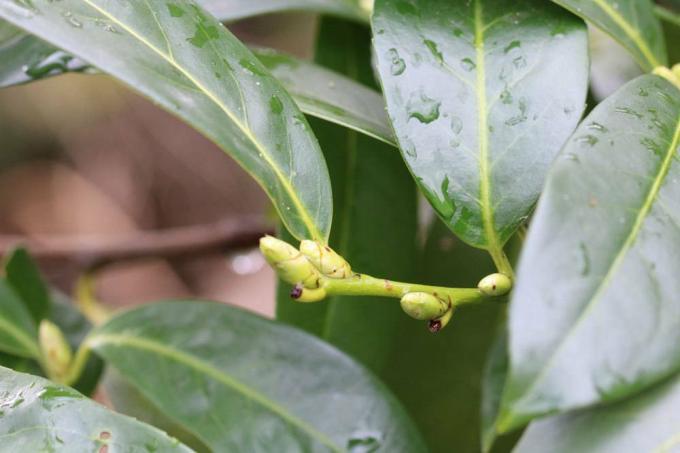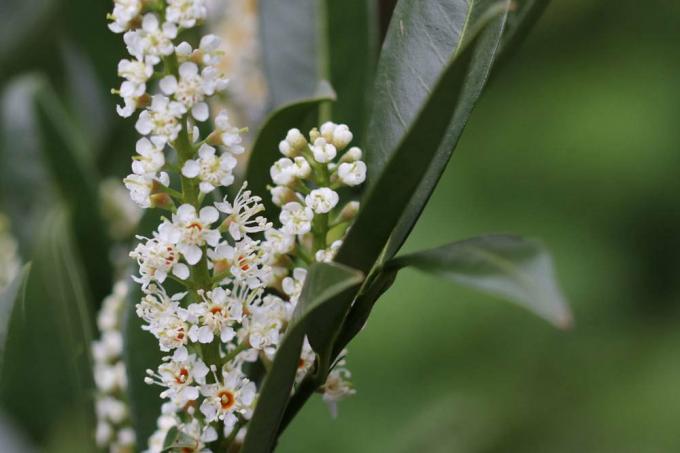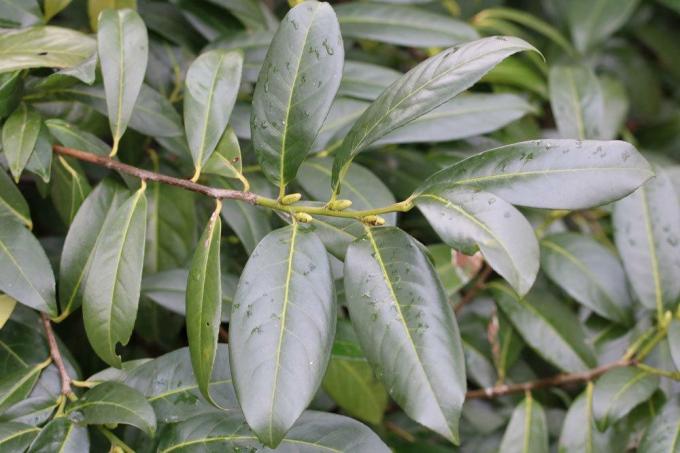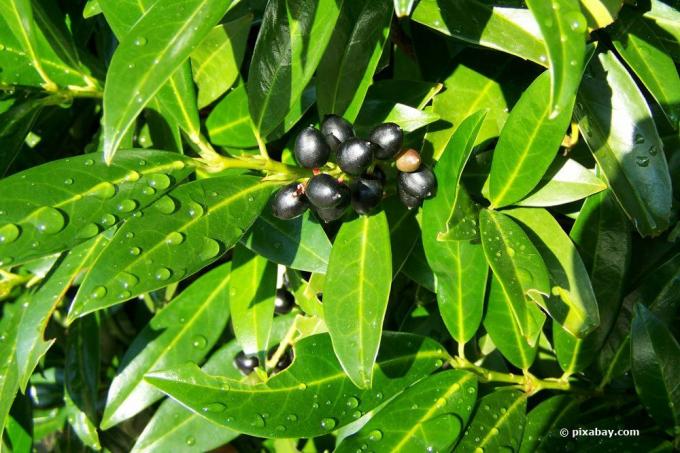
table of contents
- causes
- season
- Winter damage
- Nutritional problem
- Summer drying up
- Fungal infection
- Pest infestation
The cherry laurel is very popular because, with its dark green foliage, it brings color to gardens, especially on dreary winter days. It is all the more annoying when the leaves suddenly turn brown and the leaves fall off. Here it is important to quickly identify the cause in order to be able to react correctly. The plant expert will give you all the essential information.
causes
If the leaves of a cherry laurel turn brown, there can be several reasons. Here you should definitely investigate the cause, because if you do not react correctly, the Prunus laurocerasus threatens to die in the worst case. At the plant expert, you can find out everything you need to know about possible reasons for dealing with the appropriate Treatment measures counteract this and what else you know about brown cherry laurel leaves should.

season
The season of the year usually gives rise to suspicions as to why the leaves of cherry laurels turn brown.
winter
Most often this occurs between February and the end of March, depending on how cold the temperatures are. In this case, you can assume that your Prunus laurocerasus is suffering from the effects of winter and reacts with a brown color of the leaves.
spring
When cherry laurels get brown leaves in spring, the shoots are often too weak. In most cases this is due to a pruning error in February / March.
summer
When the flowers slowly wither in June / July and fruits form, the Prunus laurocerasus needs special care when it comes to care. Care errors are often noticeable here in the form of brown leaves as well as an incorrectly chosen location. In isolated cases, parasites and diseases could be responsible for the leaves turning brown. Fungi show up especially during the humid seasons.
autumn
If you have cut your laurel bush in summer, brown leaves, as they did in spring, could indicate that you did not cut your laurel bush optimally. But due to the mostly higher humidity in autumn, a pest infestation cannot be ruled out, which should usually be fought before the onset of winter.

Winter damage
dryness
Most laurel cherry varieties are frost-resistant and are very robust even in extremely sub-zero temperatures, but winter can nonetheless cause them problems if it was too dry or if the plant did not get enough moisture due to its location Has. This is the case, for example, when many sunny days allow the rose plant to evaporate too much moisture and frozen soil blocks sufficient moisture supply to the roots.
A typical sign of a too dry winter period are brown leaves, which mainly form in early February, but also into March. After the discoloration, the leaves become drier and eventually die off.
Frost damage
Also in February, the brown leaf color shows that there may be frost damage. This results from extreme minus temperatures in winter and when the cherry laurel species is not particularly cold-robust. If there are no measures to protect against the cold, such as placing a thick layer of straw or brushwood over the root area, frost damage occurs more often. Frost damage can also be seen through so-called frost cracks in the woody parts of the plant and on dried up branches.
Treatment:
Even if your cherry laurel looks badly worn, you can get it fit again. You can cut off brown leaves as well as dried up and frozen shoots up to a healthy tissue structure between March and April. This allows you to limit the damage in the event of extensive plant damage, in that the plant does not have to unnecessarily waste nutrients on the parts of the plant that cannot be saved. In the case of minor damage, this measure is usually sufficient and the cherry laurel recovers quickly. Choose a dry, frost-free day for your work for cutting and don't forget to water it so that any moisture deficits can be compensated.
After the ice saints in May, if you have severe winter damage, you should cut back the affected cherry laurel more vigorously. This may mean that you will have to forego a flower that year, but the chances are look good that you will have a recovered and well-leafed shrub in the garden by autumn to have.

- Shorten all dried and / or frozen twigs / shoots by two thirds
- The interface must be made at least two to three centimeters in the healthy tissue
- then cut the entire cherry laurel by half (stimulates bushy shoot growth)
- Water vigorously when there are many withered branches and leaves
- only cut on a dry, sunny day - preferably around noon
- Seal larger interfaces with carbon powder or wax if necessary (to prevent diseases)
TIP: Water your cherry laurels every now and then at milder temperatures, even in winter. If necessary, break through the layer of ice above, but never use hot water, only cold irrigation water.
Nutritional problem
When cherry laurels enter the growth phase in spring, they need a lot of nutrients until the fruits develop in summer. Especially if the soil conditions are not ideal, nutrients can quickly become deficient, which can lead to the leaves turning brown. Some hobby gardeners mean it too well with their specimen and fertilize too many nutrients. An excess of nutrients can also cause brown and dried-up leaves to develop. Here, the first discoloration of the leaf margins usually indicates a nutrient cause. Overall, the rose family looks increasingly sick.

Treatment for nutrient deficiency:
- Cut off the brown leaves and dried up shoots from the cherry laurel
- Measure the pH of the soil, it should be between 5 and 7.5, if it is below 5 fertilize with lime
- loosen old soil if it is too compacted
- then apply slow release fertilizers such as horn shavings or compost
- ideally, if possible, transplant cherry laurel in a fresh, nutrient-rich substrate
- Apply nutrient-rich fertilizer regularly about four weeks after transplanting
TIP: If the brown color moves from the leaf edge to the center of the leaf, there could be a lack of potassium. In that case, choose a special potassium fertilizer.
Treatment of nutrient oversupply:
- Cut off brown leaves and shoots
- Water vigorously over a period of four days to flush out fertilizer
- then refrain from watering for a few days until the floor has dried
- alternatively: expose the root
- "Rinse" the roots vigorously in the planting hole with a garden hose
- Allow excess water to sink as far as possible
- then refill the planting hole with lime-free soil or lime-free substrate
- only after about two months slowly and carefully start fertilizing again (minimized dosage)
TIP: If you find yourself in a heavy rainy season, you can let the rain do the work for you. Simply remove a lot of the top layer of soil so that the cherry laurel still has stability and let the rain wash out excess fertilizer.

Summer drying up
The cherry laurel always needs a moist soil environment. If you do not water regularly on hot summer days, brown leaves will quickly appear, and later on, dried-up twigs / shoots will also be clearly visible. The brown coloration usually begins here at the style and then extends over the middle of the leaf until it then reaches the leaf tip over the leaf margins.
If a drought is recognized, excessive watering may only help to a limited extent, because waterlogging forms, you may have the next problem right away, because it results in yellow leaves and root rot can. Therefore proceed as follows.
- cut off all dry parts of the plant, including the leaves, right into the healthy area
- pour morning and evening
- do not pour in the midday heat, because too much irrigation water evaporates here
- do not water in direct sunlight, otherwise burns may result
In the case of very strong drying out and cherry laurels in buckets, it is advisable to "bathe" the roots.
- Uncover or dig up the root
- Cut off any accessible dried roots
- shorten all root tips by about one to two centimeters (improves moisture absorption)
- Fill the plant hole completely with water
- or put the dug up root in a bucket of water
- if no more air bubbles form, the root has soaked up with water
- As far as possible, remove excess water from the planting hole with a cup / small bucket
- Take the planted roots out of the bucket, drain well and plant in fresh nutrient-rich substrate
- Refill the planting hole with dry, nutrient-enriched soil
- pour again as usual from the following day

Fungal infection
The robust rose plant is not armed against the direct transmission of bacteria and viruses through infected cutting tools. If you do not use the scissors or knife thoroughly before pruning in the spring and / or autumn fungal infections adhering to it can enter the Get inside the plant. The leaves usually turn brown first, then dry off, while the entire laurel loses its stability in branches and shoots.
In the case of fungal infections, such as shotgun disease, bright spots also form on the leaves. Further discoloration begins at the leaf margins. Sometimes, depending on the type of mushroom, sticky, white or shimmering silvery coatings can be seen on the leaves. Especially in damp autumn weather, mushrooms can be grown without transferring a cutting tool.
Treatment:
- cut off all affected parts of the plant with their branches or at the base of the stem
- Shorten the laurel cherry by about a third (stimulates new, strong growth)
- then carry out a treatment with a fungicide to control fungus
- Repeat the spraying twice every 14 days

Pest infestation
If you discover damage to the leaves that are turning brown, it could be a black weevil infestation, which is a typical parasite of cherry laurels. Usually these traces can only be found on the edges and tips of the leaves. Usually it appears between April and May and / or August and September. This beetle itself does not cause any life-threatening damage. It is its larvae that it deposits in the ground, which work their way to the roots and then eat them.
Treatment:
Treatment with so-called nematodes has proven to be very successful. These are roundworms that are available in a clay mineral powder for use against black weevils. These are put into the irrigation water and thus the plant is wetted and, above all, the soil / substrate is poured. The nematodes also transmit a deadly bacterium to the larvae and pupae, which they use to infect them.
